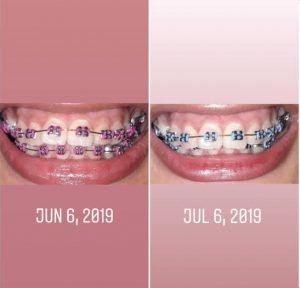BRACES RESULTS AFTER 1 MONTH
Are you interested in knowing more about braces results after 1 month? If so, then you are on the right page. Feel relaxed and make sure you read the article to the end.

BRACES RESULTS AFTER 1 MONTH
The time it takes to move your teeth into the perfect position varies with each unique smile. Thus, some people with more noticeable misalignments may wear braces much longer than others.
No matter how long treatment takes, the result is a beautiful smile, which you’ll be proud to show everyone! Next, we’ll look closer at how quickly teeth can move with braces.
Contents
Average Time for Moving Teeth with Braces
Braces move teeth by exerting constant pressure over time. Very gradually, your teeth move, and your jaw adapts, conforming to the pressure. However, the pressure isn’t enough to cause more than minor discomfort with adjustments every three to ten weeks.
In around three weeks or so, you may begin to notice your teeth feeling loser than usual. Now, your teeth are starting to move into their desired location. Although you may not see anything different, you’ll feel that changes are happening. However, you’ll also become more used to wearing braces, and the discomfort will be minimal.
Slow and Steady Movement
By the end of the first month, you may see your teeth have moved slightly. From there, each time you get your braces adjusted, your teeth will move just a little more. After several months, there will be significant movement, and people you know may notice your teeth moving.
According to the Mayo Clinic, the average time for wearing braces is between one and three years. Then, you’ll wear a retainer to ensure your teeth stay permanently in place. To get the fastest treatment, you can help by following your orthodontist’s instructions carefully.
For minor adjustments, you could wear braces for as little as six months. However, most people wear braces for longer.
Faster Treatment with the Latest Technology
Today, you can get the results you want in less time thanks to advances in braces and technology. Dr. Lints and the team at Lints Orthodontics always stay up-to-date to ensure your treatment is as fast, comfortable, and convenient as possible. Plus, treatment is affordable with payment plans to fit your budget.
When Will the Change Become Noticeable?
There are a variety of factors that affect the rate at which your teeth will start to shift. The reason that orthodontists give a range is because your treatment schedule is set according to your individual requirements.
As a general rule, your total time in braces will be between 18 and 24 months. In that time, you can start to actually notice the changes in your teeth’s appearance as early as four weeks from being fitted. But two or three months is the average expectation.
This ArchWired thread looks at some of the experiences that brace wearers had with noticing the change. The range of malocclusions is fairly wide and so the treatment times and noticeable changes are, too.
Why Does It Take This Long?
Adjusting your teeth is done incrementally using varied forces, to maximize movement in the shortest period of time. Basically, it is done as quickly as possible without doing it too quickly—both of which have their potential downsides.
If the movement is too slow, it can result in the root resorption (shortening of the roots). Too quickly and, along with greater discomfort, the supporting bone won’t have enough time to grow the bone for proper support. There is also an increased risk of root resorption.
BRACES RESULTS AFTER 1 MONTH
Your Orthodontist’s Timetable
Rest assured, as quickly as you would like to be out of your braces, your orthodontist is trying to get you out of them just as quickly—but it won’t be at the expense of a winning smile and healthy bite. Taking shortcuts or extending treatment can have detrimental long-term effects that don’t benefit anyone.
READ ALSO:DO I HAVE A CAVITY QUIZ
So while you are looking for the telltale signs that your teeth are moving towards that perfect smile, your braces and other appliances will doing their part to make sure that there is healthy bite to go along with it.
Picture The Difference
The changes can be subtle enough that you might not be aware of them at all. If you want to keep tabs on the change, take a photo at the beginning of every month and compare them. This is where you will notice the actual difference. Apps like Lapse It can help you capture the whole experience from start to finish as a sequence.
If you’re wondering what that can look like, here is a time lapse video from a treatment over 18 months:
Follow Orders
To keep the process moving along as closely to schedule as possible, following your doctor’s instructions regarding dental hygiene and appliance maintenance are vital. Otherwise your treatment can be pushed back.
BRACES RESULTS AFTER 1 MONTH
First Month of Braces Treatment
When you first get braces, an experienced orthodontist will call this an initial alignment. During the very first stage, assuming that you choose a more traditional style (more suited to more severe malocclusions), brackets are attached to each of your teeth. Often, at this point, only the upper (maxillary) brackets are applied.
An archwire attached to the brackets applies a low, constant pressure that causes tension and compression on the periodontal ligaments and teeth. As a result, the bone around your teeth is broken down on one side (resorption) and formed on the other (deposition).
By applying this pressure, the teeth can be aligned in a relatively short time (in a few cases, the results are visible within three months, depending on the initial alignment of the teeth and how closely the treatment plan is followed). Having your teeth positioned correctly is a prerequisite before starting the longer part of your treatment-fitting them together. Furthermore, most patients experience discomfort the first four to a week after their braces, expanders, and/or wires are placed, and after an activation appointment and/or a wire adjustment.
With the use of modern appliances and wires, a trusted orthodontist will exert very light force, reducing any discomfort related to orthodontic treatment. However, some mild discomfort should be expected during orthodontic treatment. Most people will eventually become accustomed to the discomfort associated with braces.
To know more detailed information about the first month of getting braces, ensure to consult your trusted orthodontist.
Schedule your appointment with a dentist today and get the treatment on time!


